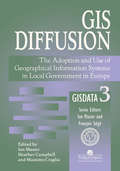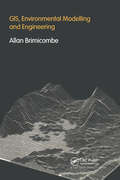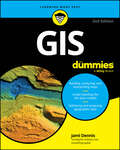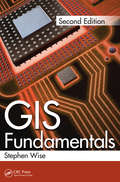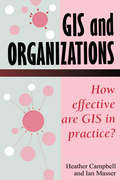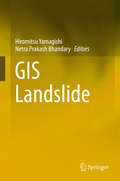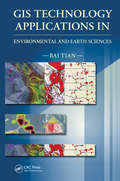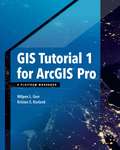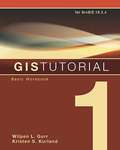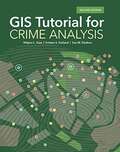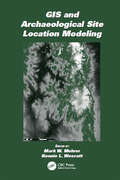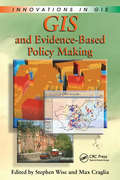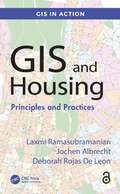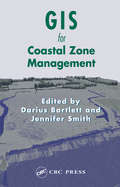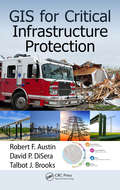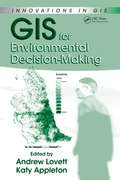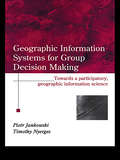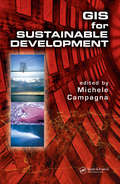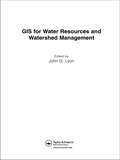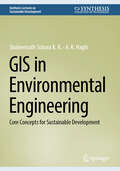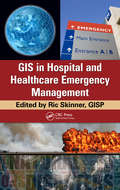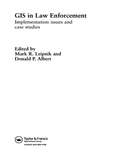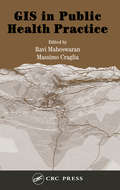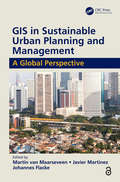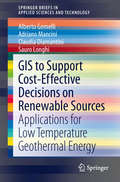- Table View
- List View
GIS Diffusion: The Adoption And Use Of Geographical Information Systems In Local Government in Europe
by Ian Masser; Heather Campbell; Massimo CragliaThis third book in the GISDATA series focuses on the widespread use of geographical information systems GIS in European local government. The editors include a wide range of applications carried out by different professional groups, and offer the opportunity of studying the extent to which diffusion of innovations like GIS are sensitive to national issues such as cultural context, institutional setup and the availability of data.; The book answers key questions such as: what can be learnt from research on organizational behaviour in relation to technological innovation?; what are the classical features of the GIS diffusion process?; to what extent is the adoption and utilization of GIS facilitated - or impeded - by the organizational culture within which it takes place?; and what mechanisms can be applied to enhance the diffusion of GIS? The book covers aspects of diffusion in the following European countries: UK, France, Italy, Poland, Denmark, The Netherlands, Germany, Greece and Portugal.
GIS Environmental Modelling and Engineering
by Allan BrimicombeThe significance of modeling in managing the environment is well recognized from scientific and engineering perspectives as well as in the political arena. Environmental concerns and issues of sustainability have permeated both public and private sectors, particularly the need to predict, assess and mitigate against adverse impacts that arise from
GIS For Dummies
by Jami DennisA jargon-free primer on GIS concepts and the essential tech tools Geographic Information Systems (GIS) is the fascinating technology field that's all about understanding and visualizing our world. GIS For Dummies introduces you to the essential skills you'll need if you want to become a geospatial data guru. You'll learn to read, analyze, and interpret maps, and you'll discover how GIS professionals create digital models of landscapes, cities, weather patterns, and beyond. Understand how advances in technology, including AI, are turning GIS tools into powerful assets for solving real-world problems and protecting the planet. This beginner-friendly book makes it easy to grasp necessary GIS concepts so you can apply GIS in your organization, pursue a career in this dynamic field, or just impress others with your geographic knowledge. Learn the basics of data analysis, interpretation, and modeling using Geographic Information Systems Gain the skills to read and interpret all types of maps and visual GIS information Discover how GIS is used in fields like urban planning, environmental science, business, and disaster management Explore whether a career in GIS could be right for you GIS For Dummies is the perfect starting point for students, professionals, and anyone curious about the potential of GIS as a technology or career choice.
GIS Fundamentals
by Stephen WiseWith GIS technology increasingly available to a wider audience on devices from apps on smartphones to satnavs in cars, many people routinely use spatial data in a way which used to be the preserve of GIS specialists. However spatial data is stored and analyzed on a computer still tends to be described in academic texts and articles which require specialist knowledge or some training in computer science. Developed to introduce computer science literature to geography students, GIS Fundamentals, Second Edition provides an accessible examination of the underlying principles for anyone with no formal training in computer science. See What’s New in the Second Edition: Coverage of the use of spatial data on the Internet Chapters on databases and on searching large databases for spatial queries Improved coverage on route-finding Improved coverage of heuristic approaches to solving real-world spatial problems International standards for spatial data The book begins with a brief but detailed introduction to how computers work and how they are programmed, giving anyone with no previous computer science background a foundation to understand the remainder of the book. As with all parts of the book there are also suggestions for further sources of reading. The book then describes the ways in which vector and raster data can be stored and how algorithms are designed to perform fundamental operations such as detecting where lines intersect. From these simple beginnings the book moves into the more complex structures used for handling surfaces and networks and contains a detailed account of what it takes to determine the shortest route between two places on a network. The final sections of the book review problems, such as the "Travelling Salesman" problem, which are so complex that it is not known whether an optimum solution exists. Using clear, concise language, but without sacrificing technical rigour, the book gives readers an understanding of what it takes to produce systems which allow them to find out where to make their next purchase and how to drive to the right place to collect it.
GIS In Organizations: How Effective Are GIS In Practice?
by Heather Campbell I. MasserIn placing these questions at the heart of their book, the authors set out to stimulate and contribute to the great debate: despite the enormous growth in the acquistion of GIS technology by business and government, little is known about the impact this leading- edge technology is having.Using case studies in a local government context, this book explores the performance of GIS in practice on the premise that any technology-led innovation will only "work" if the proper organizational and management support, infrastructure and culture exist. In doing so the authors draw on the experiences from organizational theory and management science in their quest to cast light on the processes influencing the implementation of technologies such as GIS.
GIS Landslide
by Hiromitsu Yamagishi Netra Prakash BhandaryThis book presents landslide studies using the geographic information system (GIS), which includes not only the science of GIS and remote sensing, but also technical innovations, such as detailed light detection and ranging (LIDAR) profiles, among others. To date most of the research on landslides has been found in journals on geology, geotechnology, landslides, and GIS, and is limited to specific scientific aspects. The GIS Landslide Workshop has been established in order to communicate and solve the scientific as well as technical problems of this discipline, such as how to use GIS software and its functions. Because many landslide disasters take place in Japan, most of the scientists and researchers studying landslides are concentrated within Japan. There is also much GIS data on landslides captured and stored by Japanese organizations. For that reason, it is significant that this first book on the topic has been published in Japan. Included among the chapters are analyses of deep-seated landslides; hazard mapping; measuring and visualization of precipitation, floods, and glaciers using GIS; landslides induced by earthquakes; GIS analyses of drainage systems and floods; and landslides in relation to topography and geological structures. Filled with photographs and remote sensing analyses, the volume will be of great value to those in the fields of geography, geology, seismology, environment, remote sensing, atmospheric research, and meteorology, as well as to students of computer science and programming systems.
GIS Technology Applications in Environmental and Earth Sciences
by Bai TianThis book starts with an overview of GIS technology, what GIS technology is, what it can do, what software products are available, etc. Then, throughout the book, the author explains with many case studies, programs, maps, graphics, and 3D models how GIS and other related technologies can be used to automate mapping processes, collect, process, edit, store, manage, and share datasets, statistically analyze data, model, and visualize large datasets to understand patterns, trends, and relationships to make educated decisions. This book is an excellent resource for anyone who is interested in GIS and related technologies, geology, natural resource, and environmental science.
GIS Tutorial 1 For ArcGIS Pro: A Platform Workbook (GIS Tutorials Series)
by Wilpen Gorr Kristen KurlandGIS Tutorial 1 for ArcGIS(R) Pro: A Platform Workbook is an introductory text for learning ArcGIS Pro, the premier professional desktop GIS application. In-depth exercises that use ArcGIS Pro, ArcGIS Online, and other ArcGIS apps feature the latest GIS technology to show readers how to make maps, how to create and analyze spatial data, and how to manage systems with GIS. <P><p>Incorporating proven teaching methods in detailed exercises, "Your Turn" sections, and expanded homework assignments, this book is suited to learning GIS in a classroom. Wilpen L. Gorr and Kristen S. Kurland have written the top-selling GIS Tutorial 1: Basic Workbook, GIS Tutorial for Health, and GIS Tutorial for Crime Analysis.
GIS Tutorial 1: Basic Workbook (10. 3 Edition) (GIS Tutorials Series)
by Wilpen L. Gorr Kristen S. KurlandUpdated for ArcGIS Desktop 10, GIS Tutorial 1: Basic Workbook provides effective GIS training in an easy-to-follow, step-by-step format. By combining ArcGIS tutorials with self-study exercises intended to gradually build upon basic skills, the GIS Tutorial 1 is fully adaptable to individual needs, as well as the classroom setting. The tutorial demonstrates a range of GIS functionality, from creating maps and collecting data to using geoprocessing tools and models as well as ArcGIS 3D Analyst and ArcGIS Spatial Analyst extensions for further analysis. GIS Tutorial 1 includes a data CD for working through the exercises and fully functioning 180-day trial DVD of ArcGIS Desktop10 software, making it the smart choice for GIS beginners.
GIS Tutorial For Crime Analysis (GIS Tutorials Series)
by Wilpen L. Gorr Kristen S. Kurland Zan M. DodsonGIS Tutorial for Crime Analysis, second edition, is a workbook for crime analysts and students of criminology. The book presents state-of-the-art methods that can be incorporated into any police department’s standard practices. This second edition builds upon the first edition by updating tutorials, adding a new chapter on building and evaluating predictive models using ModelBuilder and ArcGIS’s hot spot analysis tools, and adding a capstone project on hot spot modeling. In contrast to GIS workbooks that teach skills for one-time projects, this book has users build and use a crime mapping and analysis system to meet all spatial information needs of a police department. The book combines introductions to GIS and crime analysis methods and step-by-step tutorial exercises with independent assignments to teach key GIS skills, including data preparation and updating, map template building, map queries and analysis, automation of map production, and predictive modeling skills. The book also includes a 180-day trial version of ArcGIS Desktop software and tutorial data. Instructor resources are available upon request.
GIS and Archaeological Site Location Modeling
by Konnie L. Wescott Mark W. MehrerAlthough archaeologists are using GIS technology at an accelerating rate, publication of their work has not kept pace. A state-of-the-art exploration the subject, GIS and Archaeological Site Location Modeling pulls together discussions of theory and methodology, scale, data, quantitative methods, and cultural resource management and uses loc
GIS and Evidence-Based Policy Making
by Stephen Wise Max CragliaAlthough much has been written on evidence-based policy making, this is the first volume to address the potential of GIS in this arena. GIS and Evidence-Based Policy Making covers the development of new methodological approaches, emphasizing the identification of spatial patterns in social phenomena. It examines organizational issues, including the
GIS and Housing: Principles and Practices (GIS in Action)
by Laxmi Ramasubramanian Jochen Albrecht Deborah Rojas De LeonGIS and Housing: Principles and Practices discusses one of the challenges that has not been addressed by Geographic Information Science thus far: how can we use GIS to deal with the complex issues underlying the housing crisis? This book provides GIS technicians and analysts with an overview of US housing challenges and examples of how to effectively integrate spatial thinking to address housing policy questions, while simultaneously introducing housing policy analysts to advanced GIS concepts and techniques to create livable neighborhoods that include housing alternatives beyond the single family. Through numerous examples, the authors advocate for a collaborative approach that encourages professionals, policymakers, and analysts, across different ideological and political perspectives, to confront the multifaceted housing crisis. Features: Examines the historical aspects of housing provision, societal attitudes, demographic shifts, and government policies. Bridges the gaps between housing professionals and GIS experts, facilitating an interdisciplinary approach to address the housing crisis. Explores different challenges that are facing urban, suburban, and rural neighborhoods in different US regions. Provides professionals with the necessary tools for informed decision-making. Proposes solutions that leverage the integrative capacity of GIS to address established housing issues. Advocates for denser housing alternatives to address issues of affordability, supply shortages, and homelessness. This book is intended for graduate students and professionals in housing, community development, urban planning, architecture, and GIS, and anyone curious about learning more about the American housing crisis.
GIS for Coastal Zone Management
by Jennifer Smith Darius BartlettIncreasingly used to analyze and manage marine and coastal zones, Geographical Information Systems (GIS) provide a powerful set of tools for integrating and processing spatial information. These technologies are increasingly used in the management and analysis of the coastal zone. Supplying the guidance necessary to use these tools, GIS for Coastal
GIS for Critical Infrastructure Protection
by Robert F. Austin David P. DiSera Talbot J. BrooksGIS for Critical Infrastructure Protection highlights the GIS-based technologies that can be used to support critical infrastructure protection and emergency management. The book bridges the gap between theory and practice using real-world applications, real-world case studies, and the authors' real-world experience. Geared toward infrastructure ow
GIS for Environmental Decision-Making (Innovations in GIS)
by Andrew Lovett Katy AppletonEnvironmental applications have long been a core use of GIS. However, the effectiveness of GIS-based methods depends on the decision-making frameworks and contexts within which they are employed. GIS for Environmental Decision-Making takes an interdisciplinary look at the capacities of GIS to integrate, analyze, and display data on which decisions
GIS for Group Decision Making: Towards A Participatory, Geographic Information Science
by Timothy Nyerges Piotr JankowskiIn today's society, it is very common for decisions that influence us all to be made by a combination of interested parties, all with their own agenda. In this instance, how can we be sure that the decision is the correct one, not just decided by the group with the most political influence or most money? Such groups have now become fundamental deci
GIS for Sustainable Development
by Michele CampagnaGIS for Sustainable Development examines how GIS applications can improve collaboration in decision making among those involved in promoting sustainable development. This volume reviews leading GIScience, providing an overview of research topics and applications that enable GIS newcomers and professionals to apply GIScience methods to susta
GIS for Water Resource and Watershed Management
by John G. LyonThe use of GIS, and its application for solving environmental problems is growing rapidly. This powerful set of tools can be used to great effect in hydrological modeling, environment and habitat assessments, ecosystem studies, monitoring of wetlands and forested watersheds, urban studies, agricultural impact assessment and much more. GIS for Water
GIS in Environmental Engineering: Core Concepts for Sustainable Development (Synthesis Lectures on Sustainable Development)
by A. K. Haghi Shaheemath Suhara K. K.The book covers applications of Geographic Information System (GIS) and remote sensing in the fields of hydrology, water resource management, land use, rainfall variability, and groundwater mapping, to help professionals in the field identify change in patterns and guide them in making decisions that promote sustainable development.
GIS in Hospital and Healthcare Emergency Management
by GISP, Ric SkinnerAlthough many books have been published on the application of GIS in emergency management and disaster response, this is the first one to bring together a comprehensive discussion of the critical role GIS plays in hospital and healthcare emergency management and disaster response. Illustrating a wide range of practical applications, GIS in Hospital
GIS in Law Enforcement: Implementation Issues and Case Studies (International Forensic Science And Investigation Ser.)
by Mark R. Leipnik Donald P. AlbertThis is the ideal book for GIS users in law enforcement who want to learn more about the technology or who wish to get started using GIS in their agency. Crime analysts, teachers, and students of criminal justice will also gain valuable insights into a suite of powerful technological tools ideally suited for crime mapping and analysis from this com
GIS in Public Health Practice
by Massimo Craglia Ravi MaheswaranSignificant advances in the evaluation and use of geographic information have had a major effect on key elements of public health. Strides in mapping technology as well as the availability and accuracy of health information enable public health practitioners to link and analyze data in new ways at international, regional, and even street levels. Th
GIS in Sustainable Urban Planning and Management (Open Access): A Global Perspective
by Martin Van Maarseveen Javier Martinez Johannes FlackeThe Open Access version of this book, available at http://www.tandfebooks.com/doi/view/10.1201/9781315146638, has been made available under a Creative Commons Attribution-Non Commercial-No Derivatives 3.0 license. <P><P> GIS is used today to better understand and solve urban problems. GIS in Sustainable Urban Planning and Management: A Global Perspective, explores and illustrates the capacity that geo-information and GIS have to inform practitioners and other participants in the processes of the planning and management of urban regions. The first part of the book addresses the concept of sustainable urban development, its different frameworks, the many ways of measuring sustainability, and its value in the urban policy arena. The second part discusses how urban planning can shape our cities, examines various spatial configurations of cities, the spread of activities, and the demands placed on different functions to achieve strategic objective. It further focuses on the recognition that urban dwellers are increasingly under threat from natural hazards and climate change. <P><P> Written by authors with expertise on the applications of geo-information in urban management, this book showcases the importance of GIS in better understanding current urban challenges and provides new insights on how to apply GIS in urban planning. It illustrates through real world cases the use of GIS in analyzing and evaluating the position of disadvantaged groups and areas in cities and provides clear examples of applied GIS in urban sustainability and urban resilience. <P><P> The idea of sustainable development is still very much central in the new development agenda of the United Nations, and in that sense, it is of particular importance for students from both the Global South and Global North. Professionals, researchers, and students alike will find this book to be an invaluable resource for understanding and solving problems relating to sustainable urban planning and management.
GIS to Support Cost-effective Decisions on Renewable Sources
by Claudia Diamantini Sauro Longhi Adriano Mancini Alberto GemelliThrough the results of a developed case study of information system for low temperature geothermal energy, GIS to Support Cost-effective Decisions on Renewable Sources addresses the issue of the use of Geographic Information Systems (GIS) in evaluating cost-effectiveness of renewable resource exploitation on a regional scale. Focusing on the design of a Decision Support System, a process is presented aimed to transform geographic data into knowledge useful for analysis and decision-making on the economic exploitation of geothermal energy. This detailed description includes a literature review and technical issues related to data collection, data mining, decision analysis for the informative system developed for the case study. A multi-disciplinary approach to GIS design is presented which is also an innovative example of fusion of georeferenced data acquired from multiple sources including remote sensing, networks of sensors and socio-economic censuses. GIS to Support Cost-effective Decisions on Renewable Sources is a useful, practical reference for engineers, managers and researchers involved in the design of GIS, decision support systems, investment planning/strategy in renewable energy and ICT innovation in this field.
